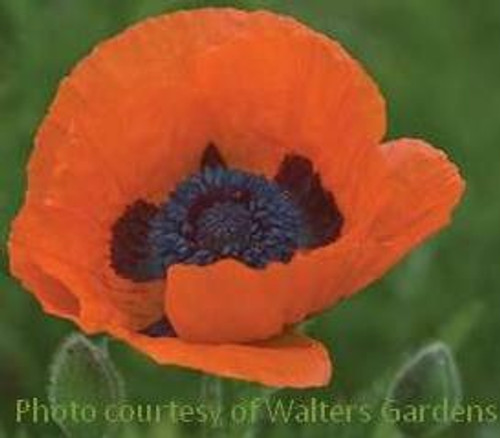Product Description
Papaver orientale 'Beauty of Livermore' (30)ct Flat
Common name: Oriental Poppy.
Deep, oxblood-red blooms are borne on wiry, pubescent stems from late spring thru early summer. This is one of the finest reds available. Its petals have a crepe-like appearance and a satiny texture. Each flower can measure 4 to 6 inches across. In the center of a poppy's flower rests a very large, velvety-black seed capsule surrounded by prominent, dark purple stamens.
After the bloom cycle is completed, foliage yellows and dies as perennial goes dormant. New leaves appear in fall and overwinter until spring when the foliage puts on growth until flowers bloom again.
Height: 30.0 Inches
Spread: 18.0-24.0 Inches
Hardiness Zones: 3,4,5,6,7
Flower Color: Red Shades
Foliage Color: Green shades
Full Sun (> 6 hrs. Direct Sun)
Average Water Needs
Average to Fertile Soil Quality
Bloomtime: Late Spring - Early Summer
Attracts Hummingbirds
Deer and Rabbit Resistant
Seasonal Interest: Dried Seed Heads
Growth Rate: Medium
Border Plant, Cut Flower, Cut Foliage, Dried Flower, Specimen
Papaver orientale 'Beauty of Livermore' is a truly captivating Oriental poppy cultivar that is renowned for its large, deep red flowers and striking presence in the garden. It is a classic choice for adding a bold splash of color and a touch of drama to borders and beds. Here is a closer look at its key features:
Appearance:
- Deep Red Flowers: 'Beauty of Livermore' produces huge, bowl-shaped flowers in a deep, oxblood-red color. The petals have a crepe-like texture and a satiny sheen, adding to their allure. The flowers can reach up to 6 inches in diameter, creating a dramatic focal point in the garden.
- Black Center: The center of each flower features a prominent, velvety-black seed capsule surrounded by dark purple stamens, providing a beautiful contrast against the deep red petals.
- Hairy Foliage: The flowers emerge from a mound of finely cut, hairy, grayish-green foliage that adds texture to the garden.
Growing Conditions:
- Sunlight: Thrives in full sun (at least 6 hours of direct sunlight per day).
- Soil: Prefers well-drained soil. It is adaptable to various soil types, but good drainage is essential.
- Hardiness Zones: Suitable for USDA hardiness zones 3-7. It is best suited for cooler climates and may struggle in areas with hot and humid summers.
Care:
- Low Maintenance: 'Beauty of Livermore' is a relatively low-maintenance plant.
- Watering: Water regularly, especially during dry periods, but avoid overwatering.
- Deadheading: Deadheading spent flowers can encourage additional blooms and prevent self-seeding.
- Foliage Dieback: The foliage tends to die back after flowering, leaving a gap in the garden. You can interplant with other perennials to fill the space.
Uses:
- Borders: Adds a bold splash of color and drama to borders and beds.
- Cottage Gardens: Its informal and romantic appearance makes it a good fit for cottage gardens.
- Specimen Plant: Its large, eye-catching flowers make it an excellent specimen plant.
- Cut Flowers: The flowers are suitable for cutting and using in arrangements, but they do not last long.
Additional Information:
- Short Bloom Time: Oriental poppies have a relatively short bloom time, typically flowering for a few weeks in late spring to early summer.
- Self-Sowing: 'Beauty of Livermore' can self-sow, so you may find new seedlings popping up in the garden.
- Deer and Rabbit Resistant: Deer and rabbits tend to avoid Oriental poppies.
- Attracts Pollinators: The flowers attract bees and butterflies.
If you are looking for a dramatic and eye-catching perennial with large, deep red flowers, Papaver orientale 'Beauty of Livermore' is an excellent choice. It is a classic and reliable addition to any sunny garden, adding a touch of bold color and elegance.
Thirty (30) plants per flat (or tray). Approximate Plug Measurements: 3 inches deep x 2 inches wide.
Other Details
The most important part of the plant is its root system. Healthy roots are the foundation of a healthy, vibrant plant. The type of plug container used is based on the specific needs of the plants. Perennials offered as bare root traditionally perform better when planted as bare root.Planted in a specialized mix, potted plants have well established root systems. Top growth stage will vary depending on the current life cycle and time of year when shipped. In Winter and early Spring dormant plants may be shipped. Dormant plants may be planted right away, even before the last frost date.
Most bare root varieties are field grown for at least one season, though Hemerocallis and Hosta are grown for two seasons. The bulk of the soil is removed during the harvesting process and the tops of most varieties are trimmed back to the crown. They are graded, packed in shredded aspen or sphagnum moss and stored in freezers until ready to be shipped.
See our Container Sizes and Bare Root Perennials pages for more information.
Plant information and care is provided in the Overview section, Plant Genus Page and general information is provided in the Planting Care & Guides. Additional questions can be asked on each Plant page.
Plant Spacing: Using the maximum mature spread or width of a plant to guide spacing, ensures space to grow to full size. To fill an area sooner, plant them closer together. Just remember, future thinning or transplanting may be needed.
Water: Keep a close eye on newly planted perennials, especially throughout the first growing year. Most early plant loss is due to too much or too little water!













